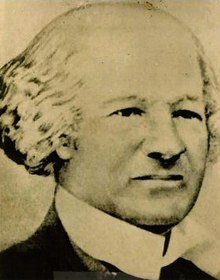James P. Allaire
| James Peter Allaire | |
|---|---|
 |
|
| Born |
July 12, 1785 New Rochelle, New York, United States (probable) or Annapolis Royal, Nova Scotia, Canada (possible) |
| Died | May 20, 1858 (aged 72) Howell Works, New Jersey |
| Cause of death | Old age (age of 72; after a brief illness) |
| Resting place | Allaire Family Cemetery, Old Huguenot Cemetery, New Rochelle, New York |
| Residence | New York Colony and State |
| Nationality | American Colonist (United States) |
| Education | Less than Elementary (undocumented) |
| Occupation | Industrialist, Engineer, Inventor, Merchant, Philanthropist |
| Political party | American Loyalist (Familial) |
| Spouse(s) | Frances Duncan (January 25, 1804 – March 23, 1836) Calicia Allaire Tompkins (1846 – May 20, 1858) |
| Partner(s) | Charles Soutinger |
| Children | 10 Maria Haggerty Allaire Andrews Hal Allaire (born 5 October 1847) |
| Parent(s) | Peter Alexander Allaire |
James Peter Allaire (July 12, 1785 – May 20, 1858) was a noted master mechanic and steam engine builder, and founder of the Allaire Iron Works (est. 1815), the first marine steam engine company in New York City, and later Howell Works (est. 1822), in Wall Township, New Jersey. His credits also include building both the first compound steam engine for marine use and the first New York City tenement structure.
Allaire was born either in his family's ancestral home city of New Rochelle, New York, or under self-preserving exile in Annapolis Royal, Nova Scotia, Canada. A large number of "Tory" Loyalist individuals and families fled New York to Canada during the British evacuation of New York after the Paris Peace Treaty of 1783 ended the United States War of Independence, including branches of the Allaire Family that took residence in Annapolis Royal, Nova Scotia. Petitions to the Continental Congress in 1784 by a Peter A. Allaire of New York, a Colonial American Loyalist, indicates a high probability that the relevant branch of the Allaire family may have remained in New York during and after the British evacuation. Sometime after 1793, the Allaire patriarch purchased a house in New York City, and found work as a livery stabler.
In 1802, at the age of 17, his oldest son, James Peter, began working for Francis Elsworth, a brass founder in the city. Allaire would marry Frances Duncan, a distant cousin, two years later, and he continued to advance at the brass foundry. They would eventually have nine children, five of whom lived to adulthood.
By 1806, having learned the brass business, Allaire opened his own foundry. Before the War of 1812, Allaire’s foundry received an order from Robert Fulton to make the brass works for the Clermont, the first commercially successful steamboat. After Fulton’s death in 1815, Allaire leased that gentleman’s Jersey City, NJ shop and tolls from the estate. He then took as a partner Charles Soutinger, Fulton’s chief engineer. Under that partnership, Allaire and Stoutinger built the engine for Fulton’s last steamship design, the Chancellor Livingston, as well as the air cylinder for the Savannah, the first steam powered vessel to successfully cross the Atlantic.
...
Wikipedia
